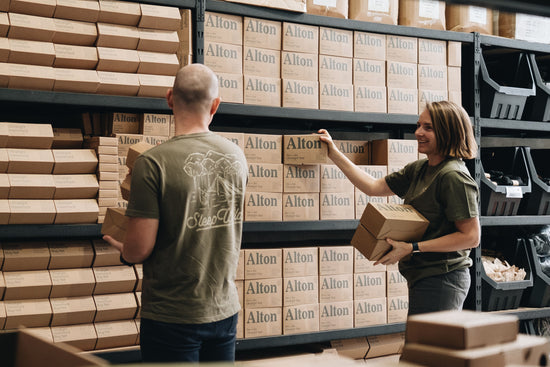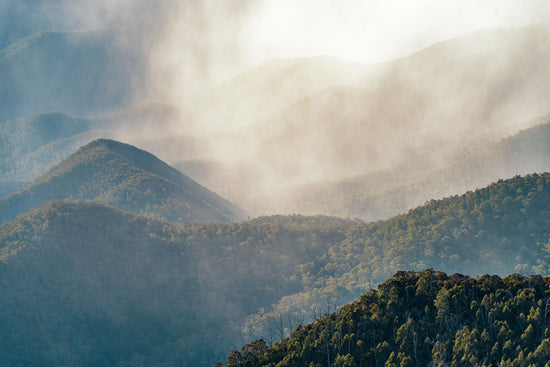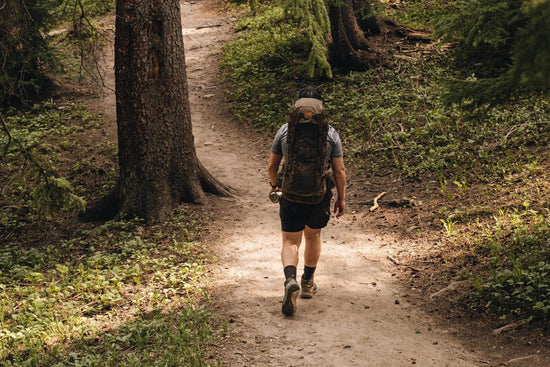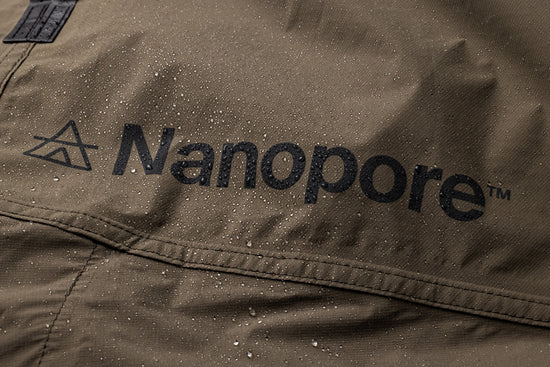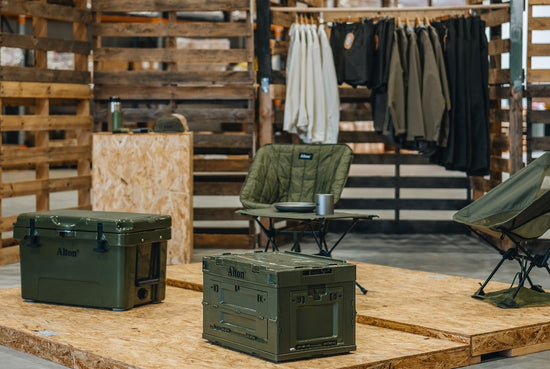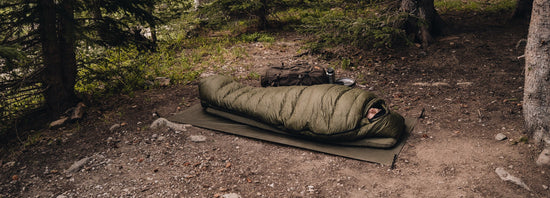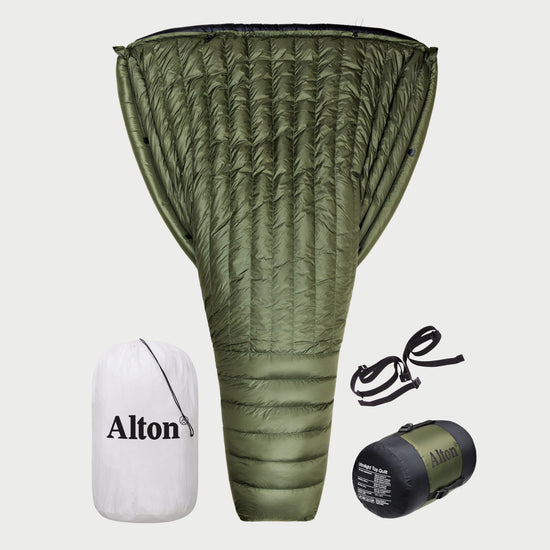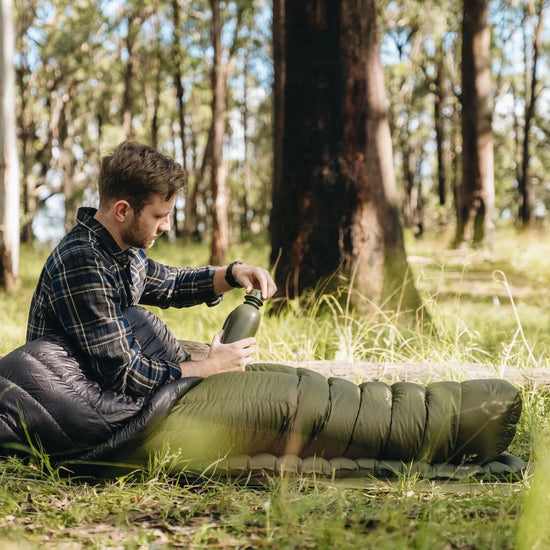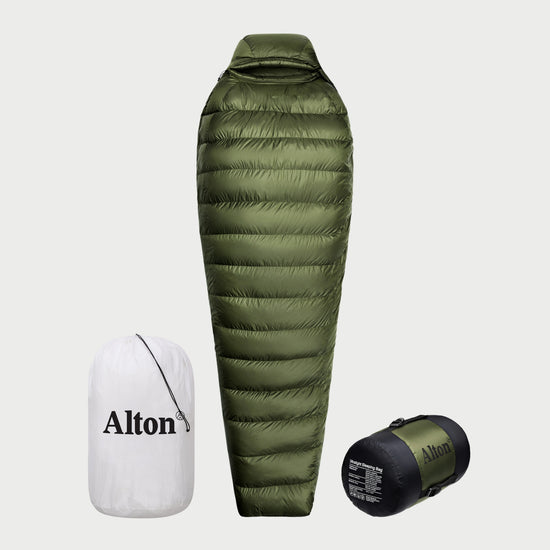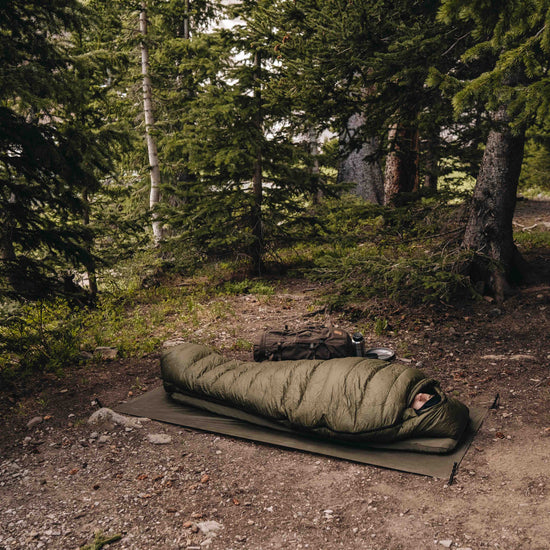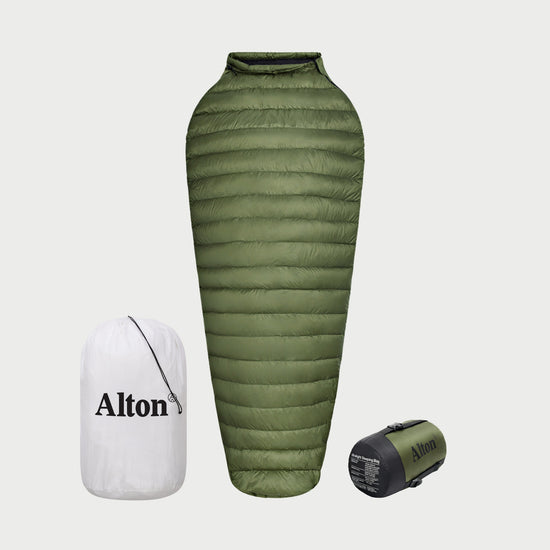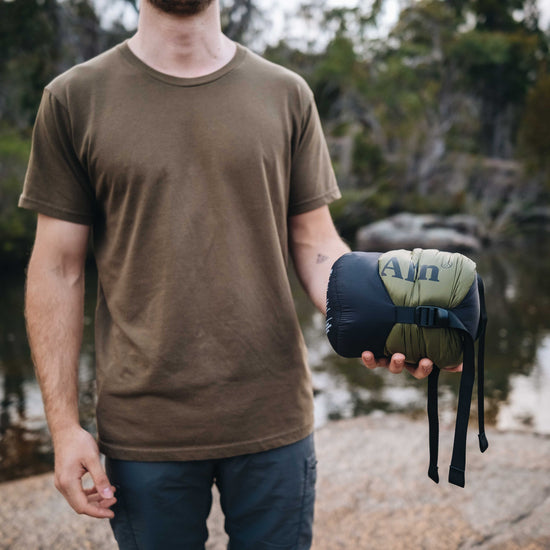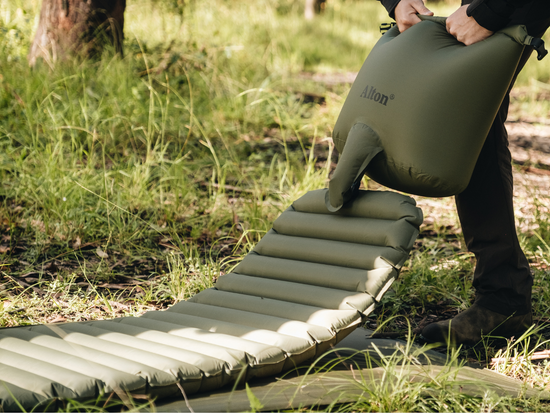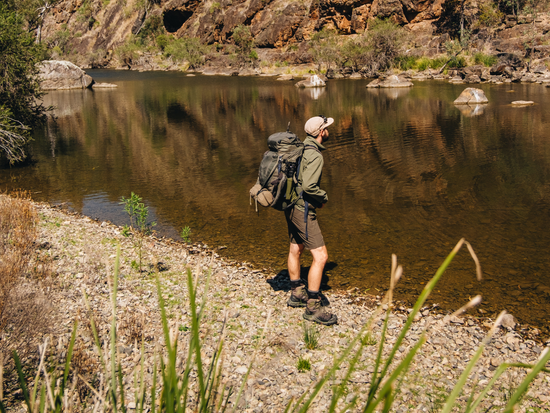After a long day of hiking, nothing beats settling in for a well earned rest under the stars. But, as any seasoned outdoors person will tell you, having suitable gear for the conditions is essential to staying safe and enjoying your trip.
Although sleeping bags have set the standard for a long time, camping quilts are increasingly becoming the go-to for ultralight campers. The key difference between the two is that a sleeping bag for camping can be completely enclosed around you, whereas a quilt has an open back and no hood. Instead of using a zipper to seal you in, quilts are designed to attach to your sleeping mat utilising a strap system, creating a warm envelope around you.
So, how do sleeping bags and quilts compare across the key performance considerations of warmth/temperature regulation, weight/packability, setup/ease of use and, last but not least, sleeping comfort? We break it all down so that you can see which option is right for you.

Warmth & Temperature Regulation
The warmth from any sleeping bag or quilt comes from the loft of their filling. The greater the loft, the more trapped air the filling can accommodate and subsequently the more warmth the item can provide. That said, insulation only does its job when it is expanded – as soon as it is compressed, it loses the ability to provide warmth. Because of this, the back of a sleeping bag, where it is flattened by your body weight, is unable to store heat. This is one of the key reasons why an insulated sleeping mat is essential in cold conditions, regardless of whether you are using a sleeping bag or a quilt. Without it, your body heat quickly escapes into the ground.
Advantages of using a sleeping bag
Sleeping bags are designed to keep you toasty by sealing you into a draught-free cocoon. Aside from summer sleeping bags designed for warmer conditions, winter sleeping bags usually have hoods to seal in the warmth even further. Because they maximise heat retention, it is hard to go past a sleeping bag in freezing conditions. Plus, because most feature full or partial zippers, temperature regulation is fairly straightforward. On warmer nights, your sleeping bag can be unzipped as much as needed to allow air in.
Advantages of using a quilt
Camping quilts are designed to give you insulation where it is most effective, on top and around you, and skip it where it is compressed and redundant underneath you. This nifty design allows quilts to save valuable weight and pack down smaller, all while often featuring greater down fill to keep you cosy. They also offer excellent temperature regulation. With the freedom of movement that comes with a quilt, it is easy to stick your arms or legs out to find your ideal temperature, without having to worry about fighting with your sleeping bag’s zipper in the middle of the night.
Sleeping bag vs quilt: which option is better for warmth and temperature regulation?
It all depends on the conditions you’re planning to sleep in. In cold conditions, if you had a winter sleeping bag and a camping quilt with the same temperature rating, the sleeping bag would provide slightly better heat retention because it can be completely sealed around you. But, the difference is not huge, and quilts have plenty of other benefits that may outweigh a minor risk of draughts. Many quilt fans still choose a quilt for winter camping, opting to wear a beanie and an extra layer of clothes if they want a thermal boost. And, in milder weather, a quilt is hard to beat, with the open design allowing for superior airflow.

Weight & Packability
It is worth being pedantic about how much weight you carry when hiking. An unnecessarily heavy pack can make an otherwise fun adventure pretty miserable, not to mention increase the chances of injury. Sleeping bags and quilts take up a significant portion of space and weight in your pack, so it pays to be selective when choosing one. Every gram adds up, after all!
Advantages of using a sleeping bag
The luxury of zippers and excess material in your sleeping bag for camping comes at the cost of added weight, which can be a deal breaker for ultralight hikers. Still, the small amount of extra weight may be worth the trade off depending on the conditions you plan to use it in.
Advantages of using a quilt
A big part of camping quilts’ rise to prominence has come from their impressive warmth-to-weight ratio. Zipperless, hoodless and with less material overall, quilts are usually lighter and pack smaller than sleeping bags of the same temperature rating.
Sleeping bag vs quilt: which option is better for weight and packability?
When it comes to weight and packability, it is hard to beat a camping quilt. Although a hiking sleeping bag might have an edge when it comes to warmth, that comes at the cost of extra bulk and weight if compared to the equivalent temperature rated quilt. Camping quilts do an excellent job of shaving off superfluous weight, making them an appealing choice for anyone looking to lighten up their pack on a long hike.

Setup & Ease of Use
Although you may not immediately think of set up and ease of use when shopping for a sleeping bag or camping quilt, these are factors worth considering.
Advantages of using a sleeping bag
When it comes to a fast, easy set up, sleeping bags are golden. Just unstuff your bag, put it on your sleeping mat and climb on in. Sweet dreams!
Advantages of using a quilt
For those who enjoy fine-tuning their camping set up, quilts can be a lot of fun. Even after the initial learning curve of using the attachment system to fasten the quilt to your mat, each night will require a few minutes of fine tuning your set up before you can hit the hay.
Sleeping bag vs quilt: which option is better for setup and ease of use?
The answer to this one comes down to personal preferences. If you want to fast track to curling up in bed after a long day of hiking, then a sleeping bag is definitely going to be the way to go. If you get a kick out of optimising and customising your gear to be just right, you will probably love the flexibility that quilts give you to create your ideal sleeping system.
Wondering what option is best for hammock camping? A top quilt, paired with an underquilt for when it gets chilly, will be far more functional compared to your standard hiking sleeping bag. Not only does sleeping bag loft get severely compressed in a hammock, but getting in and out of a zipped sleeping bag in a hammock can be complicated, to say the least.

Sleeping Comfort
Sleeping comfort is the final piece of the puzzle when it comes to choosing a sleeping bag or camping quilt. When weighed alongside the other points we covered, it can be the deciding factor for your choice.
Advantages of using a sleeping bag
Many folk love the cosy, tucked in feeling that sleeping bags can provide them. Especially in winter conditions, nothing beats having your own capsule of warmth to enjoy all night long. But remember that you will still need a sleeping mat with the appropriate R-value if you don’t want to end up losing all that precious warmth to the ground!
Advantages of using a quilt
Fans of camping quilts will tell you that one of the best things about them is that you can sleep in almost any position. With the attachment system to hold your quilt in place, you have the freedom to roll and wriggle around throughout the night without getting tangled or twisted.
Sleeping bag vs quilt: which option is better for sleeping comfort?
Only you have the answer to this one. Want to spread out and have freedom of movement? You may love the spaciousness of a camping quilt, where you can sleep in just about any position. Or, maybe you like the snug-as-a-bug feeling of a sleeping bag and the extra security against the cold that comes along when fully enclosed.

The Final Say
The final choice between ultralight sleeping bags and an ultralight quilt comes down to personal preference and the conditions in which you plan to use them.
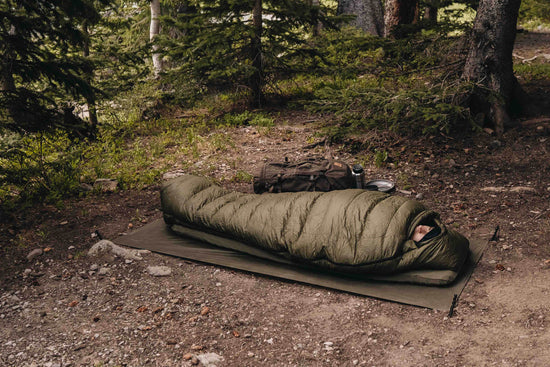
Ultralight Sleeping Bag
Pros
- Draught-free cocoon. Be completely enclosed around you, whereas a quilt has an open back and no hood.
- Fast, easy setup. Just unstuff your bag, put it on your sleeping mat and climb on in.
Cons
- The back of a sleeping bag, where it is flattened by your body weight, is unable to store heat.
- Extra weight. The luxury of zippers and excess material in your sleeping bag for camping comes at the cost of added weight, which can be a deal breaker for ultralight hikers.
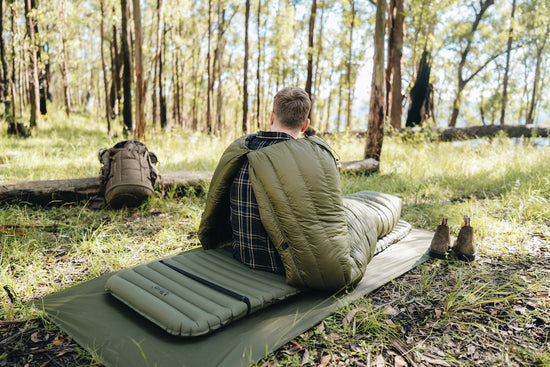
Ultralight Top Quilt
Pros
- Lightweight & compact. save valuable weight and pack down smaller, all while often featuring greater down fill to keep you cosy.
- Freedom of movement. It is easy to stick your arms or legs out to find your ideal temperature and airflow.
Cons
- Requires a sleeping mat or hammock to create a warm envelope around you.
- Can be susceptible to draughts, though there are other methods to maximise warmth if needed.
You should choose a sleeping bag if…
- You want maximum warmth without the risk of draughts during the night.
- You don’t mind carrying a little extra weight for the sake of having a little extra security.
- You like the idea of a quick, easy set up when you’re making your bed for the night.
- You prefer a cosy, cocoon-like feel when you are sleeping.
- You mainly plan to do your sleeping on solid ground, not in a hammock.
You should choose a quilt if…
- You are not fussed about the safeguard of ‘zero draughts’ – you have other methods to maximise warmth if needed.
- You are striving to get your pack lighter and want something that takes up less space.
- You geek-out on perfecting your setup and like to take your time fine tuning it.
- You prefer to have the freedom to move or spread out while you sleep.
- You want the versatility to be able to sleep comfortably in a hammock as well.
Although there is no perfect option for every occasion, by weighing up the factors we have covered, you should be able to feel confident that you are making the right decision. As always, if you have any questions or want to learn more about our products, reach out to our team of experts – we’ll happily help you find the perfect gear for your adventures.
